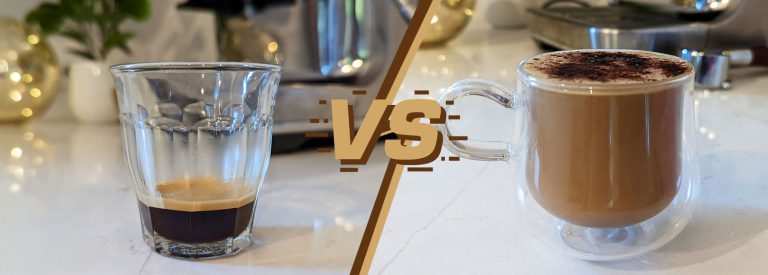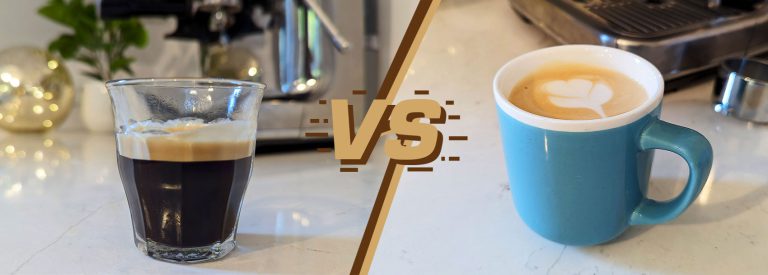Ristretto vs Latte: What Sets These Brews Apart?
Ristretto and latte are 2 very different coffee drinks, with both rooting from the humble espresso.
In this article, I want to dive deep into the differences between the two, as well as give tips and recommendations on how to prepare and serve them, so make sure you read till the end.
Key takeaway: What’s the difference between Latte and Ristretto?
Ristretto is a concentrated form of espresso, with a coffee-to-water ratio of 1:1.5, resulting in a dense, syrupy, and intense flavor with a hint of sweetness and tanginess. On the other hand, a Latte uses the standard 1:2 to 1:3 coffee-to-water ratio of espresso combined with 3 to 6 parts of steamed milk, yielding a creamy, mild, and smooth drink.
Now without any further ado, here are the nuances of each drink.
What is Ristretto?
Ristretto is an Italian term that translates to “restricted”, which will already give you an idea of how it relates to the espresso. It refers to the ristretto’s limited amount of water during brewing a normal espresso, which turns it into a more intense drink with different flavor notes.

The specific coffee-to-water ratio when preparing a ristretto is 1:1.5 using 7g of coffee grounds (9g for third-wave coffee) per shot. What you’ll get is a 0.7 oz (20ml) coffee served in a demitasse that can hold 60–90 ml (2–3 oz). If you’re watching your caffeine or calories, each ristretto shot comes with 60 to 80mg of caffeine (just like an espresso) and just 2 calories.
Let’s discuss the flavor profile and texture of the ristretto. Since it’s a more concentrated espresso, it has a thick and syrupy mouthfeel with an enhanced bold flavor. The shorter extraction time also amplifies the natural sweet notes and aroma of the coffee while reducing any bitterness and possibly adding acidity with light-roasted beans. It’s complex, a bit sweet, and tangy all at once.
Here’s a quick guide on how to prepare a ristretto:
- Grind your coffee beans to the standard espresso grind size.
- Place the coffee grounds in the filter basket.
- Tamp the coffee grounds evenly and firmly.
- Lock the portafilter in your espresso machine and press the brew button.
- Pull a shot for just 15-18 seconds.
Yes, the steps are exactly the same as an espresso, just with a shorter extraction time. If you want more details on pulling a proper ristretto, you can read my guide on how to make a Ristretto.
Now let’s explore latte next.
What is a Latte?
The term roughly translates to “coffee and milk” which is a pretty straightforward description of the drink. It’s been a part of coffee culture since the 1500s, but contemporary coffee chains like Starbucks have made it super popular since the 1980s.
In specialty coffee, it also found further popularity with baristas showing off their latte art skills. Here is a simple one I was able to make even with my broken pointing finger 🙂

To make a latte, you want to maintain the 1:2 to 1:3 coffee-to-water ratio of espresso. This is then combined with 3 to 6 parts of steamed milk with a thin microfoam layer on top. The final serving ranges from 150 to 480ml (5 to 16 oz) that’s poured into a latte mug.
So how about calories and caffeine? The latte has 60-80mg of caffeine per shot of espresso and 128 calories for a 240ml serving. This is for the usual full-fat milk that is best if you want to make latte art designs. You can also use alternatives like soy, almond, and oat milk, but they steam differently and make latte art more challenging.
Now about the taste, the Café Latte comes across as a gentle and creamy espresso-based drink. The boldness of espresso is nicely balanced by the sweetness and creaminess of the milk. Obviously, the more milk you use, the less coffee you taste, which is why with the larger sizes, you use a doppio (double shot).
Here’s how you can make a latte at home and save $5:
- Prepare a single or double espresso.
- Pour cold milk into a steaming pitcher up to the bottom of the spout.
- Steam the milk to around 160 degrees Fahrenheit, aerating it to create a silky texture with microfoam.
- Pour the steamed milk over your espresso.
- You can show off a bit with your latte art.
If you need more details to nail that latte, you can read my step-by-step guide on how to make a Caffé Latte.
Also, there are many other types of lattes you’ll find in my espresso and milk recipe list.
Ristretto & Latte Compared: Similarities and Differences
To help you get a clear picture of how ristretto and latte compare against each other, here’s a quick comparison table:
| Aspect | Ristretto | Latte |
|---|---|---|
| Taste and Texture | Dense, syrupy, bold, and intense | Creamy, mild, smooth, and velvety |
| Coffee-to-Water Ratio | 1:1.5 | Espresso in Latte: 1:2 to 1:3 |
| Ingredient Ratio | Just coffee with less water than an espresso | 1 part espresso, 3-6 parts milk, & thin microfoam layer |
| Typical Serving Size | 0.7 oz (20 ml) | 5 to 16 oz (150 to 480 ml) |
| Caffeine Content | 60-80 mg per shot | 60-80 mg per 1 oz shot of espresso used |
| Calories | 2 calories per shot | 128 calories for a 240ml serving |
| Acidity | High acidity | Low to moderate acidity |
| Brewing Difficulty | Intermediate | Home barista |
| Bean Roast | Medium roasts | Medium roasts |
Now, I’ll give you a breakdown of their distinct characteristics:
- Ground Coffee Weight & Ratios: Using 7g of ground coffee for a shot or 14g for a double shot (9g and 18g respectively for third-wave coffee), the ristretto follows a strict coffee-to-water ratio of 1:1.5.
Meanwhile, a latte uses the usual espresso shot with the same amount of coffee grounds and a brew ratio of 1:2 to 1:3. One part espresso is then combined with 3 to 6 parts of steamed milk with a thin microfoam layer. Except at Starbuck’s, where it can go as high as 1 part espresso to 8 parts milk. - Taste: Ristretto is known for its robust and concentrated taste, highlighting the sweet and aromatic nuances of your coffee beans. It can get overly acidic though if you use light roast beans. In contrast, the Café Latte is a rich yet mild coffee that combines the intensity of espresso and the creaminess of milk.
- Volume, Calories, & Caffeine: A ristretto is served in smaller portions of 0.7 oz (20 ml), whereas lattes come in bigger amounts of 5 to 16 oz (150 to 480 ml).
These two beverages offer the same caffeine content per shot which is 60 to 80mg. Lattes are more caloric, carrying around 128 calories for a single serving of 240ml while a ristretto will only give you about two calories. - Bean Roast: I make both my ristrettos and lattes with medium roast beans. These are great due to their ability to give my ristretto a balance between boldness and a hint of sweetness while also nicely complementing the milk used in lattes.
- Steamed Milk: The addition of milk also differentiates these two coffee types. Ristretto has no milk while lattes are espresso merged with steamed milk and topped with a thin layer of microfoam. Usually, whole milk is used but substitutes like almond, soy, or oat milk can be incorporated as well.
To learn more about preparing milk for your coffee, you can follow my guide on how to steam milk for lattes. - Serving Suggestions: I like to enjoy my ristretto by pairing it with small sweets like chocolate truffles and cookies. As for lattes, I like the soya latte because of the soy milk’s distinct flavor 🙂
Both the ristretto and latte start off being prepared like an espresso, but the process and final flavors differ. The ristretto uses less water for a more concentrated coffee while the latte uses more coffee and adds steamed milk to make a milder brew.
To begin your brewing right, you want to pick your coffee beans properly. For this, you can check out my list of the best espresso coffee beans this 2025.
Summary
If I had to pick between the two right this instant, I would say that I like the ristretto better. Its boldness, intensity, and depth of flavor resonate with me right now, after a meal. But if you ask me in the afternoon, I would probably pick the latte 🙂
But that’s just my (big) cup of coffee 😉 How about you, which coffee do you prefer?








